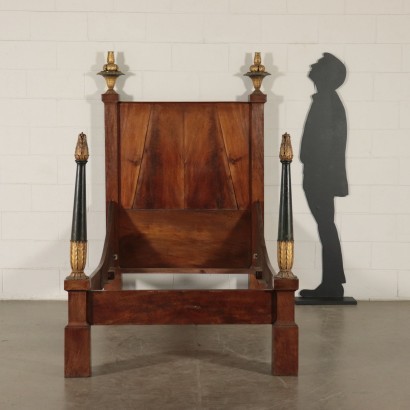Letto Impero Toscano
Features
Style: Empire (1804-1815)
Age: 19th Century / 1801 - 1900
Origin: Toscana, Italy
Main essence: Walnut
Description
Letto impero di provenienza toscana sorretto da piedi a plinto; i montanti della pediera sono costituiti da due colonne tornite ebanizzate, ornate con elementi intagliati con foglie di lauro intagliate e dorate alla base, mentre la sommità presenta una pigna, anch'essa dorata e intagliata. Sopra i montanti della testiera vi sono due elementi a pinnacolo, intagliati a foglie d'alloro, di acanto e cornici baccellate, interamente dorati. In legno di noce.
Product Condition:
Prodotto in discrete condizioni che mostra alcuni segni di usura.
Dimensions (cm):
Height: 41
Width: 100
Depth: 146
Bed frame maximum sizes (cm):
Height: 179
Width: 123
Depth: 215,5
Additional Information
Style: Empire (1804-1815)
Decorative style of the furniture that is affirmed under the Empire of Napoleon Bonaparte, that is, between 1799, the year of his election as consul, and 1815, the year of his definitive defeat.It has many elements of continuity with the previous Direttorio style, in the more general Neoclassical climate, which derived from the study of classical antiquity the forms and models to be inspired in the creation of furniture.
The peculiar feature of this style is a greater grandeur and courtesy of the furnishings, which had to convey the grandeur of the French nation to the world, hence the name Empire style.
The furniture is characterized by straight, majestic and massive lines, adorned with motifs dear to Napoleon such as bees, eagles, large Ns surrounded by laurel, and, after the Egyptian campaign, many elements taken from Egyptian art.
He prefers the flat bronze decorations, often gilded, to the refined carvings of previous years.
The typical essence of Empire furniture is mahogany.
Find out more with our insights:
Classic Monday: How society influences the taste in furnishings
Classic Monday: Empire, one style of furniture with political purposes
Classic Monday: in the Empire bed roots of culture
Classic Monday: the timeless charm of a toilet Empire






















